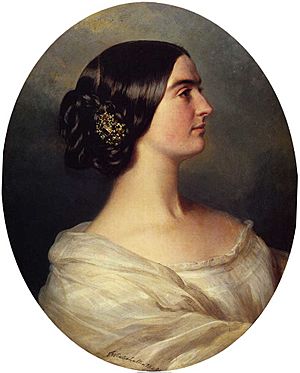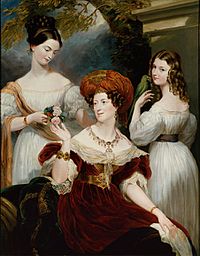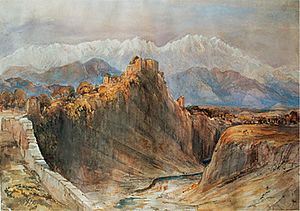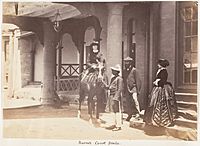Charlotte Canning, Countess Canning facts for kids
Quick facts for kids
Charlotte Canning
|
|
|---|---|
| Countess Canning | |

Lady Canning, by Franz Winterhalter (1849)
|
|
| Born | 31 March 1817 Paris, France |
| Died | 18 November 1861 (aged 44) Calcutta, Bengal Presidency, British India |
| Buried | Barrackpore, West Bengal, British India |
| Noble family | Stuart of Bute |
| Spouse(s) | Charles Canning, 1st Earl Canning |
| Father | Charles Stuart, 1st Baron Stuart de Rothesay |
| Mother | Lady Elizabeth Yorke |
Charlotte Canning, Countess Canning (born Stuart; 31 March 1817 – 18 November 1861) was a talented British artist. She became the first vicereine of India. A vicereine is the wife of a viceroy, who is a ruler acting as the king's representative.
Lady Canning was one of the most active women artists in India. She created about 350 watercolours during her time there. These drawings are now kept in the Victoria and Albert Museum. Her husband was Charles Canning. He served as the Governor-General of India from 1856 to 1858. Later, he became the Viceroy of India until 1862.
Charlotte was born and grew up in Paris, France. Her father was the British ambassador there. In 1831, she moved to England with her family. Four years later, she married Charles Canning. From 1842 to 1855, Lady Canning worked for Queen Victoria. She was a close friend and helper to the Queen.
In 1856, she moved to Calcutta (now Kolkata) when her husband became Governor-General. In 1858, India came under the direct control of the British Crown. This made her husband the Viceroy and Charlotte the first Vicereine. As an artist and a person interested in plants, Lady Canning collected flowers and plants. She also drew the beautiful natural scenes she saw during her trips around India. She became sick just before she was supposed to return to England. She sadly died of malaria in Calcutta.
Contents
Early Life and Marriage

Charlotte Stuart was born on 31 March 1817. Her birthplace was the British embassy in Paris. Her father was Sir Charles Stuart. He was the British ambassador at the time. Her mother was Lady Elizabeth Yorke.
Charlotte's grandmother, the Countess of Hardwicke, was there when she was born. She wrote that Charlotte looked very much like her father. Charlotte was named after her godmother, Queen Charlotte. A year later, her younger sister, Louisa Anne, was born. Both sisters were known for their beauty.
Charlotte lived in Paris with her family until 1831. She learned to speak French very well. When her father's job as ambassador ended, they moved back to London. In 1834, Charlotte was introduced to London society. Soon after, she met Charles Canning. He was the son of a former Prime Minister.
Charles Canning asked Charlotte to marry him, and she agreed. At first, her father did not approve. He had political disagreements with Charles's father. But eventually, he allowed the marriage. Charlotte married Charles Canning on 5 September 1835. The wedding took place in London.
In 1837, Charles became Viscount Canning. This made Charlotte Viscountess Canning. In 1859, Charles was given an even higher title, Earl Canning. So, Charlotte became Countess Canning.
Working for Queen Victoria
In 1842, Charlotte was chosen to be a Lady of the Bedchamber to Queen Victoria. This meant she became a close helper and friend to the Queen. She was liked by both Queen Victoria and her husband, Prince Albert. Charlotte accepted the job quickly. She wrote that serving the Queen made her feel proud and happy.
She held this important position until 1855. Charlotte was well-suited for the role. She was connected to important families. She was also intelligent, polite, and beautiful. She spoke French fluently, which was helpful in social situations. Being a Lady of the Bedchamber was mostly a ceremonial job. Charlotte was a companion to the Queen. She went with the Queen on daily outings and to formal events. She also entertained royal visitors and dined with the Queen.
Life in India

In 1856, Lord Canning was made Governor-General of India. So, Charlotte and her husband moved to India. They lived in Government House in Calcutta. Charlotte found the formal life there a bit boring. She wrote that its biggest problem was its "intense dullness." The couple often stayed at Barrackpore, a place about sixteen miles from Calcutta.
Lady Canning loved the natural beauty of Barrackpore. She was very interested in plants. She said the "luxuriant growth" there was more beautiful than she could describe. She often thought of the famous Palm House at Kew Gardens in England.
Lady Canning was in India during the Indian Rebellion of 1857. This was a major uprising against the rule of the British East India Company. It lasted from May 1857 to July 1859. Her husband was criticized by some for being too forgiving to the rebels. But the Cannings had the strong support of Queen Victoria.
After the rebellion ended, India came under the direct control of the British Crown. Lord Canning became the viceroy, which is like a king's representative. This made Charlotte the country's first vicereine. Her new position did not have official duties. However, she played an important social role and helped with charity work.
-
At Simla with her husband and Lord Clyde, 1860.
Her Art and Interests
Charlotte sometimes felt alone because of her high position in India. She found comfort in collecting and drawing India's plants. She spent a lot of time in the garden at Barrackpore. She was an amateur artist who loved using watercolours. She kept many books filled with her artwork.
Historians say Charlotte was one of the most skilled women artists of plants in India. She filled 19 volumes with her drawings. These are now kept at Harewood House. She was also one of the first people to take photographs in India.
Charlotte was also very interested in natural history. She collected plant samples when she traveled with her husband. Her cousin once noted that Charlotte's "genuine love of plants and flowers" made every trip interesting for her. She also traveled by herself. She kept a journal and wrote often to Queen Victoria. She shared detailed stories about life in India with the Queen. She also sent nature samples to Victoria's children. Queen Victoria wrote back regularly, and many of their letters still exist today.
Death and Legacy

After five years in India, Charlotte was excited to return to England. She planned to leave in January 1862. Queen Victoria had even offered her a special job at Greenwich Park. In October, Charlotte took one last trip to see the mountains near Darjeeling. She continued her trip into November, returning to Calcutta.
During her journey, she became ill. She died of malaria at Government House, in her husband's arms. She was buried in a small garden at Barrackpore. Her husband described it as a "beautiful spot" next to a river she loved to draw. News of her death reached Queen Victoria shortly before her own husband, Prince Albert, died in December.
Lady Canning's death was widely reported in England. It caused a lot of sadness. She was seen as a symbol of good qualities for women across the British Empire. Her death was said to have made Calcutta feel very sad. Lord Canning was heartbroken. He visited her grave every day. He was usually a very private person, but he cried when the Bishop of Calcutta comforted him. He sent details of her last days to Queen Victoria. He didn't know that the Queen was also grieving her husband.
Lord Canning did not live much longer than his wife. He died the next year from a liver illness. His relative, Hubert de Burgh-Canning, 2nd Marquess of Clanricarde, arranged for her tomb to be built. By 1913, her grave and memorial were next to St John's Church in Calcutta. People can still visit it today.
Two collections at the Victoria and Albert Museum hold many of her watercolours and drawings. In India, a sweet dessert called ledikeni (or "Lady Kenny") is named after Lady Canning. It is a sweet made from a type of cheese and flour, soaked in sugar syrup. There are different stories about how the dessert got its name. One story says a baker named it after her birthday. Another says it was made to celebrate her visit to India in 1856. It is said that the dessert became famous more because of its name than its taste. Eating ledikeni became popular among wealthy Bengali people in the years after her death.






